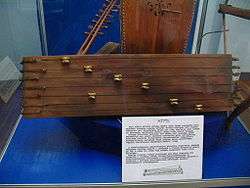Jetigen
The jetigen (Kazakh: жетіген, pronounced [ʑjɪtjɪɣjɪn], or dzhetigan or zhetygen) is a Kazakh seven-stringed zither. It is related to other Asian instruments, including the Chinese guzheng, Japanese koto, Mongolian yatga, Vietnamese đàn tranh, and Sundanese kacapi. The strings were sometimes made of horsehair.[1] Zhetygen is stringed plucking instrument, which reminds of gusli or lying harp. The most ancient type of zhetygen had 7 strings looked like the prolonged box hollowed out of the wooden piece. Such zhetygen did not have the upper sounding board and pins. The strings were stretched by hand from the outer side of the instrument. Later the upper part of zhetygen was covered with the wooden sounding board. Assyks were out under each string from two sides. Moving them it was possible to tune the string. If assyks were drawn closer to each other the tune was rising, and if drawn apart the tune was falling. String tuning was made by the pins and by moving the supports. Early instruments took the form of a rectangular box, carved from wood, with strings stretched over the top. Later, a separate sounding board was added, and moveable supports were used to raise each string from the sounding board; the position of each support along its string determined the pitch of that string's note.[2]
 | |
| String instrument | |
|---|---|
| Other names | A Kazakh jetigen on display in the Kazakhstan National Museum of Instruments. |
| Classification |
|
| Developed | Antiquity |
| Related instruments | |
References
- Carole Pegg (2001). Mongolian Music, Dance, & Oral Narrative: Performing Diverse Identities. University of Washington Press. pp. 89–. ISBN 978-0-295-98112-3.
- "Committee of Tourism Industry of the Ministry of Tourism and Sport of the Republic of Kazakhstan :: Kazakh musical instruments". kazakhstan-tourist.isd.kz. 2009. Retrieved 2015-11-29.